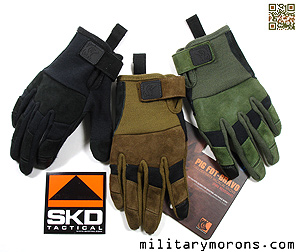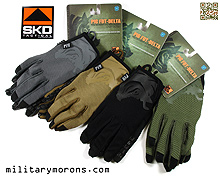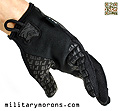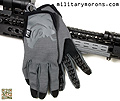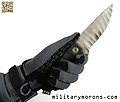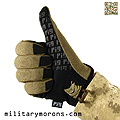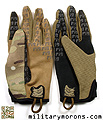TO VIEW FULL SIZE IMAGES: USERNAME and PASSWORD are both "mm"
MultiCam Mechanix Original Glove
| 9/29/14 - Mechanix Wear recently released Crye MultiCam versions of three of their most popular gloves models - the Original, FastFit and M-Pact. Mechanix Wear - Mechanix Wear has been around for over 20 years, and is one of the most recognizable glove brands. Starting out by building specialized hand protection for professional race teams and mechanics, their gloves are a common sight in auto parts and hardware stores. Over the years, the Mechanix Wear line has grown to include gloves for general use, construction, outdoors, safety, and of course tactical/military. Mechanix gloves are designed to protect against daily hazards and injuries ranging from abrasions, cut and puncture wounds, vibration injuries, broken bones or joint damage, and flame/heat. Crye MultiCam gloves - Ever since the Crye MultiCam was introduced, just about everything that you could carry or wear has been offered in the popular pattern, whether practical or not. One of the more elusive items has been gloves. The main reason for that was lack of a suitable glove material in the MultiCam pattern. MultiCam gloves have been made using the various fabrics offered bu Duro, including the stretch woven and even NYCO ripstop. Mechanix Wear's partnership with Crye allowed them to get the MultiCam pattern printed on the desired material - TrekDry, which is a moisture-wicking quick-dry knit fabric consisting of 95.5% polyester and 4.5% Spandex. Mechanix offers three of their popular gloves in Crye MultiCam - the Original (shown here), FastFit and M-Pact. The Original is based on their best-selling original design that has been updated over the years and comes in a variety of colours and configurations. It's a basic model without any frills, or hard protection.
Features - Here's a rundown of the features of the MultiCam Original Glove:
Fit, feel etc - The Original MultiCam glove is a slightly looser on my hands than some other gloves I've tried, like the Pig FDT-Alpha or SWMS/Camelbak. They snugged up a bit after putting them through the washing machine and dryer. The synthetic suede material is also a bit thicker/stiffer than FDT-Alpha and other 'shooter' gloves, as the Mechanix glove is more of a general use glove than one specifically designed for shooting. That being said, you also get more durability out of thicker material. They felt a bit stiff when brand new, but I noticed that they got softer with use, which improved dexterity. I performed my standard 9mm magazine loading test and coin test. I was able to pick up and load 9mm rounds easily into the magazine both by sight and feel - no problems at all. When it came to the coin test, I was able to pick up the quarter, nickel, penny and dime from the table. I also tried loading .22LR into my Glock conversion pistol mags, and was able to do so with a bit of fumbling. I've found that besides material thickness, the biggest contributing factor to the finer dexterity is the fit at the finger tips. Extra length or loose material gets caught and in the way when loading mags or performing detail tasks, so it's imperative to have your fingers all the way at the end of the fingertips. I'd rather have glove finger lengths that are slightly too short than too long. I have not found glove size to be very consistent between glove manufacturers, or even between different models from the same manufacturers. This, combined with different hand and fingers sizes of individuals makes this a trial and error kind of thing. On my hands, the Mechanix Original Multicam glove finger length is a tad longer than on the Pig FDT-Alpha, and Camelback Vent gloves, but about the same as some of the Outdoor Research and Arc'teryx gloves, which also tend to fit on the larger side. Notes/Observations - For shooting, I prefer my gloves to be very snug with no extra room. While that may make them a bit more difficult to doff, it's important to me to be able to feel and manipulate all the weapons' controls. While the Original MultiCam glove fits a bit looser on me (your mileage may vary, of course), they worked just fine for most range tasks. The one-piece, single layer palm without any seams is necessary (in my opinion) for any glove used for shooting, especially in the web between the thumb and index finger, so the Original MultiCam glove was very comfortable throughout the day. The rubber wrist adjustment tab is secure and easy to use. It doesn't get in the way at all. I also tried the glove out on our older iPad 2 and newer iPad Air to test touch-screen compatibilty. I was able to swipe and press with some pressure on the iPad2, but had issues with the iPad Air. I wasn't able to operate the iPad Air consistently. The MultiCam fabric on the glove seems to have a very thin layer of padding, which adds protection for the back of the hand. The subdued Mechanix heat transfer logos on the fabric are very subtle and non-reflective, so they're barely noticeable. If you've been waiting for MultiCam gloves to finally have everything matching, or really can benefit from the camo pattern (no matter how small the item), I think you'll be pleased with the Mechanix Original MultiCam gloves.
|
Arc'teryx LEAF Assault Glove FR
| 8/14/15 - The Assault Glove FR is a new addition to the glove lineup from Arc'teryx LEAF's (Law Enforcement and Armed Forces) division. It's a flame-resistant assault glove that is designed to have exceptional tacticle dexterity and touch sensor capabilities. Description - In the LEAF glove section on the previous page, I've featured some other models offered by Arc'teryx LEAF, which have been 'militarized' versions of their civilian glove line. The Assault Glove FR is exclusive to the LEAF division, targeted specifically at LE/Mil customers or those having a need for such a glove.
The Assault Glove is constructed mostly of leather, with TenCate Defender M 10 oz interlock flame resistant fabric on the back of the hand. The palm is touch-screen compatible Tsunami leather, while the knuckles and back of the fingers are goat skin. Note that the images on the Arc'teryx website show a black palm; the production gloves came with a brown palm. The Arc'teryx Dead Bird logo is embossed towards to outside of the knuckles. There's a small webbing loop on the inside of the wrist for hanging the gloves from a carabiner; attached to the pull-tab reinforcement. The glove is secured around the wrist with a leather velcro wrist tab.
Features - Here's a rundown of the features of the LEAF Assault Glove FR:
Fit, feel etc - The Assault Glove FR is the snuggest fitting leather LEAF glove they've offered yet, since the others were intended more for cool/cold weather or as a work glove (as in the Tactician). The Assault Glove FR fits like most other shooting/flight gloves; and provide better dexterity and tactile feel than any other LEAF glove. It does feel like a more substantial glove than most, though, due to the almost all-leather construction. Also, the leather isn't paper thin, so I'd expect better durability with these gloves than the less expensive ones. For dexterity/tactiIity, I did my standard 9mm magazine loading test and coin test. Compare to the standard issue Nomex flight glove, dexterity is unrestricted and tactility (feel) is slightly reduced; which is to be expected as the leather is slightly thicker. I was able to pick up and load 9mm rounds into the magazine both by sight and feel (eyes closed). I next did my unscientific coin test, and I was able to pick up the quarter, nickel, penny and dime easily from the table more easily than with the issue flight glove. On the issue flight glove, the leather part of the index fingertip is smooth and rounded. On the Assault Glove FR, the fingertips on the index finger and thumb come to a point/seam, which help grab the edges of the penny and dime. The same points on the fingertip also aid when using the touch screen on my Blackberry. I had no issue swiping or selecting any items on the screen with the Assault Gloves FR. Typing using the buttons on the Blackberry was more challenging, and I had to get used to which part of the thumb or index finger to use. I also found it possible to type on my computer keyboard with the gloves with only a few typos.
Notes/Observations - Arc'teryx makes quality stuff. That's pretty apparent when I pick up anything made by them. The Assault Glove FR is no different with the neat, tight stitching and rich smell of genuine leather. Put the Assault Glove FR next to another glove and you can see the difference in quality of the leather and construction. It's to be expected though, as the Arc'teryx glove isn't cheap. The only glove I've seen comparable in price is the Outdoor Research Overlord line of gloves which also hover around the $150 mark. Based on the full leather fingers and knuckles on the Assault glove, I also expect the Assault Glove FR to be more wear-resistant and last longer than gloves that use less leather and more FR fabric. In my experience, it's typically the stitching/junction between the leather and FR fabric that busts, or holes get worn in the FR fabric. One thing I noticed was that the wrist tab can do with another 1/2" to 3/4" of length to get more overlap of the velcro. When the tab or fully closed and overlapping the velcro on the wrist completely, the wrist opening is impossibly small. There's no way anyone is going to have such a small wrist with normal sized hands. If you look in the picture on the right, the tab is fully tightened but a lot of hook velcro is left exposed; and I have pretty small wrists already. I found that the exposed hook velcro would sometimes snag/catch on my Velocity Systems Rugby shirt material when I was at the range. I'd like to see the hook velcro on the wrist shortened, or the tab lengthened for more overlap.
At the range, the gloves performed as I expected. The leather is slightly thicker than pure shooting gloves like the PIG Alpha, so some feel is reduced at the finger tips. That's the trade-off for better durability, insulation and wear resistance. The Assault Gloves were just fine to shoot both rifles and handguns with, and I could operate all controls and change magazines without any issues. For shooting, I like to have my gloves too tight rather than too loose, and the Assault Gloves are pretty much a perfect fit on me, with no excess space at the fingertips. They're very comfortable gloves, and after a day of shooting, got more supple and felt like soft driving gloves. I was able to don and doff gear, and perform all tasks throughout the day with the gloves on. I really appreciated the thicker leather when I was swapping out muzzle devices on my rifle. I had three different muzzle devices that I wanted to compare to each other, so I had to shoot, then swap one out for another as quickly as possible and shoot again. As a result, the barrel and devices got really hot. I've done this before with synthetic suede fingered gloves, and they melted at the finger tips and I got a little burned. With the Assault Gloves, they provided enough insulation at the fingertips to allow me to remove and replace muzzle devices; holding onto them for as short a time as possible. When I removed my gloves for lunch I was suprised to see that my hands had turned orange! It was a hot day at the range and I perspired a lot, so the dyes from the leather had bled onto my hands. Unlined drum dyed leather gloves do bleed dye until most of the dye is gone - I've gone through this with motorcycle gloves turning my hands black. So, I decided to give the gloves a soaking to get the extra dye out (see below). I made the assumption that they should be able to survive inclement/wet weather and the occasional dunking in the field. I do not recommend readers doing this, and do not assume any responsibility for any damage done to the gloves; but they seem to have come through pretty much unscathed, except that the embossed dead bird logo isn't as sharp anymore. The orange hands were the only issue I encountered with the otherwise superb gloves.
|
Patrol Incident Gear FDT- Bravo Glove
| 3/26/16 - The new FDT-Bravo FR Glove is the fire-resistant version of the popular FDT-Alpha (Full Dexterity Tactical) Glove from Patrol Incident Gear (PIG), and is designed with many of the game-changing features from the FDT-Alpha. Patrol Incident Gear is a maker of tactical gear, including plate carriers, chest rigs, etc. and is the 'house brand' of SKD Tactical. Background - When the FDT-A glove came out more than three years ago, it quickly became very popular with the shooting community as it was exactly what many shooters were looking for in a glove at an affordable price. The goal of the FDT-B glove is to provide the most dextrous fire resistant gloves available for tactical applications, by combining flame protection with the same kind of dexterity for the shooter by minimizing impact on the shooter's grip. This means that padding and extraneous layers have been eliminated on the palm and fingertip tactility has been optimized.
The Bravo FR glove features full Nomex® and premium leather construction, and is the result of hundreds of hours of development and testing. It's the natural choice for those who already like the fit and feel of the Alpha glove, but need a fire resistant tactical glove option. Leather is used for most of the glove construction, and Nomex is used for the back of the hand, sides of the fingers (fourchettes), back of the thumb, and stretch panels on the backs of the proximal phalanges. Ultra thin sheepskin is used on the trigger finger. Touchscreen-compatible thread is sewn into the tips of the index finger and thumb.
Features/Manufacturer's specs:
Notes/Observations - The FDT-Bravo glove is the logical progression after the Alpha, given the demand for an FR version of the FDT-Alpha. I initially thought that the Bravo would be an exact clone of the Alpha; with only the substitution of FR materials. There are, however, design differences between them. Apart from the different materials, here are some of the more obvious differences that I noticed:
The short cuff design of the Bravo is the same as that of the Alpha, which ends forward of the wrist and allows unhampered rotation and flexing of the wrist. The the low profile wrist adjustment tab keeps the glove securely on the hand. The wrist tab is flat and thin - just like it should be, with nothing sticking out to snag. The only way to get it thinner would be to use the die-cut hypalon tabs used on some jacket cuffs. The webbing pull tab can be cut off if desired but I see no need to do that. The 'Flex Joints' sewn into the backs of the fingers on the Bravo are located at the distal joints instead of the proximal joints, as the leather doesn't stretch. The Nomex panels stretch a bit, so those are used on the back of the proximal joints. The Bravo also has the tailored fourchettes - the strip of leather narrows at each finger joint then widens again. This is to reduce bunching due to excess fabric when the fingers are bent. While the Alpha and Bravo gloves are not cold-weather gloves; the Bravo will provide more insulation than the Alpha in cold weather. Note that fire resistance does not equate to heat insulation. This applies to any other FR garment that is not designed to provide insulation. While Nomex does not melt easily, you can still sustain burns through any FR gloves if you attempt to handle hot items such as barrels or silencers. I've melted the Clarino tips of my Alpha gloves from messing around with hot muzzle devices, so be careful. Fit, feel etc - I've seen different glove models from the same manufacturer fit drastically differently, which can be frustrating if you're basing the fit of one model to purchase another one. Consistency in fit is tough to find, so I was glad to find the fit of the Bravo to be very similar to that of the Alpha. The Bravo feels slightly snugger when new, but will break-in nicely after wearing it a few times. Finger length was also very close between my Alpha and Bravo gloves. The one anomaly was the right little finger on the Coyote gloves; it was tighter than all the others, but loosened up after wearing it for a while. Due to the genuine leather construction of the Bravo FR gloves, the optimal fit will be achieved after a little bit of a break-in period. I performed my standard 9mm magazine loading test and coin test. Since the leather is thicker than that on the Alpha, I expected a slight decrease in tactility. Still, I was able to pick up and load 9mm rounds easily into the magazine both by sight and feel. When it came to my regular "coin test", I was able to pick up the quarter, nickel, penny and dime easily from the table. The wrap-over construction of the Bravo finger tips allow me grab the edges of the coins with the material, as well as feel them. On other gloves with box construction, there's a seam right at the finger tip between the pad and the tip. This seam results in a loss of feel right at that point. The wrap-over construction of the Bravo means that there is no folded material or seam right at the crucial tip of the finger, so everything can be felt through the single layer of leather. I also put the Bravo through the same challenge which I put the Alpha through: Typing (by feel - without looking at the keys). I was able to type with an accuracy of roughly 80% without looking at the keyboard. You may laugh at a typing test with tactical gloves, until you try it. Then, you'll see how important the lack of seams on the fingertips and proper fit is. Try to do it with fingers that have excess length is an exercise in frustration. I picked typing because I think that it's a good standard of measure of the tactility and fit of a glove designed for detailed work, that anyone can try out themselves. 'Tactical' tasks are not limited to weapons manipulation and shooting; they can also include operating buttons and dials on a radio/comms equipment, NVG/GPS units or even a cell phone; donning and doffing tactical gear or accessing contents of pouches. It becomes even more important when those tasks have to be performed in low light or in the dark, and rely on touch. Having to take your gloves on and off becomes a hassle. The Bravo gloves performed very well for shooting, which I expected. Carbine and pistol control manipulation, shooting, reloading etc. were just as good as the FDT-Alphas. It's only the very fine tasks like typing or operating small buttons on a camera where there's a slight difference. One thing I did notice was that the genuine leather on the Bravo has better grip/traction on smooth surfaces than the synthetic Clarino leather on the Alpha. This was one of the only areas where I felt could be improved on the Alphas.
I also noticed that the Bravos were not as effective on touchscreens. Conductive thread is sewn into the fingertips on the index finger and thumb. The stitching was a bit tighter, and the thread didn't protrude from the surface of the leather as much, as the leather on the Bravo is thicker than that on the Alpha. For the conductive thread to work, it has to contact your fingertip inside the glove, and the touch screen surface. I asked SKD about it, and they recommended 'fluffing up' the threads a bit with hook velcro, so it wasn't embedded as much. That improved it some, but it was still iffy with all the glove colours. I made it work sometimes by pressing hard on the screen, but it wasn't optimal. Hopefully they find a fix for that. Some customers have noticed this, some have not. Another small 'negative' is that the Nomex material will pill slightly after time or exposure to hook velcro; which is common with many Nomex materials. If you liked the FDT-Alpha glove and need an FR version of it, I'm pretty sure you'll be happy with the FDT-Bravo.
|
Patrol Incident Gear FDT- Delta Utility Glove
| 8/28/16 - The new FDT-Delta Utility Glove is the latest addition to the FDT (Full Dexterity Tactical) line from Patrol Incident Gear (PIG), and is designed as a lower-cost option from their previous models that still provides a superior, high-dexterity fit. Patrol Incident Gear is a maker of tactical gear, including plate carriers, chest rigs, etc. and is the 'house brand' of SKD Tactical.
Background - When the FDT-A glove came out more than three years ago, it quickly became very popular with the shooting community as it was exactly what many shooters were looking for in a glove at an affordable price. It was followed by the fire-resistant FDT-Bravo glove and the women's version of the FDT-Alpha; the FDT-Charlie. The goal of the FDT-Alpha glove was to provide the best dexterity for the shooter by minimizing impact on the shooter's grip. This means that padding and extraneous layers had been eliminated on the palm and fingertip tactility was optimized. Over the past three years, the FDT-A has been my go-to shooting glove. The FDT-D (Delta) is intended as a lower-cost option to the already affordable FDT-A by simplification of construction and foregoing some of the extra features found on the FDT-A.
The Delta Utility glove is a slip-on glove, instead of having velcro wrist adjustment tabs like the Alpha and Bravo. Also eliminated from the Delta are the micro-suede nose wipe on the back of the thumb, padded knuckles and hand knife-edge padding. Elimination of these features results in simplified construction with fewer panels and labour, thus reducing cost. The FDT-D is made up of the same stretch nylon fabric as the FDT-A, as well as the Clarino synthetic leather. Features/Manufacturer's specs:
Notes/Observations - My first impressions of the FDT-Delta were very positive. They're a no-frills, functional, good-looking glove. There's a large subdued, rubberized PIG hog's head logo on the back of the hand which adds some uniqueness to the look of the glove. It's not entirely decorative, as I suspect that it does provide a layer of abrasion-resistance to the back of the hand. I wouldn't mind seeing some applied to the knuckles. The palm of the FDT-D don't have the vent holes that are on the FDT-A, and a rubberized repeating 'Pig' on the fingers and thumb for added grip have been added; two things that I had actually commented on in my FDT-A writeup:
I was really happy to see both these points addressed on the FDT-Delta glove. The bartacked paracord pull tab inside the wrist is covered by a molded PIG logo as well; with both the logo and cord colour-matched to the glove, which I thought was a nice detail. The lack of wrist adjustment tab worried me a bit when I first saw that the FDT-Delta was a slip-on, because slip-on gloves don't always stay on properly. Some rely on a bit of elastic to add tension around the wrist, like the standard Nomex summer flyer's glove, and those have to be pulled up from time to time as they sometimes slip down the hand. This is typically because of the lack of stretch material used where it needs to go over the hand before contracting behind the hand on the wrist. For an elastic cuff to keep the glove on the hand securely, it has to be designed properly (obviously). Seems like a no-brainer but I've seen more than a few slip-on gloves that just aren't that secure. For gardening work, that can be overlooked, but for shooting, where it's important to have no slippage at all to interfere with gripping or manipulating the weapon, slippage is unacceptable. Well, I was relieved to find that the FDT-Delta gloves were indeed designed correctly, and incorporated an expanding spandex gusset to allow the glove to be pulled over the hand, then keep tension behind it to keep it from slipping forward. The Delta is not as easy to don as the Alpha, since the cuff is tighter, but I found that the easist method of donning it was simply to pull it with the 550 pull cord while wiggling the fingers.
All the FDT-series gloves have short cuffs, which end forward of the wrist and allows unhampered rotation and flexing of the wrist. The Delta doesn't have the 'Flex Joints' sewn into the backs of the fingers like on the Alpha and Bravo, but I can't really feel a practical difference, other than slightly less tension when I bend my fingers when wearing the Alpha. The Delta also shares the tailored fourchettes that the Alpha and Bravo have - the strip of leather narrows at each finger joint then widens again. This is to reduce bunching due to excess fabric when the fingers are bent. Until the FDT-Alpha came along, for a pure summer shooting glove, my favourite for years was the Southwest Motorsports (SWMS) Vent CT, which was discontinued a few years back and then made by Camelbak. The one drawback to the Vent CT was durability; the thin mesh back was perfect for hot weather use, but wasn't very abrasion resistant. I was disappointed when SWMS stopped making them in grey and Camelbak only offered them in black. They haven't been available for some years and the FDT-Delta takes over that summer glove role most excellently. The issue with many tactical gloves is that they get beefed up to improve protection for the hand and increase durability, but then dexterity suffers, making them less than optimal for shooting. The FDT-Alpha sacrificed some durability for feel and dexterity, and the FDT- Delta follows that same philosophy. Glove are meant to be consumables and discarded when worn out, but we all want to get as much longevity out of them as possible; so we sometimes expect them to last longer than they're designed to. Even though the FDT-A's are relatively inexpensive at $43 a pair, PIG has tried to make it all the more palatable by offering the FDT-D at $13 less. On the touchscreen-compatible version of the Alpha and Bravo, conductive thread is sewn into the fingertips on the index finger and thumb. When using the Alpha and Bravo gloves, effectiveness was sometimes spotty. The conductive thread has to contact your fingertip inside the glove and the touch screen surface for it to work. Sometimes the stitching would be tighter and the threads not exposed as much so SKD recommended 'fluffing up' the threads a bit with hook velcro, so it wasn't embedded as much in the fingertips. I'd also sometimes use a part of the fingertip where there wasn't any conductive thread, and I'd have a failed swipe or touch. Another issue with the conductive thread was that it would wear over time. The FDT-Delta addresses that by having the thumb and index finger made completely of touchscreen-compatible material; no conductive thread/stitching needed. This is far more effective and I have much better results on touchscreens with the Deltas. It beats having to remove gloves at the range when someone wants you to take a picture or video of them on their smart phone. Fit, feel etc - I've seen different glove models from the same manufacturer fit drastically differently, which can be frustrating if you're basing the fit of one model to purchase another one. Consistency in fit is tough to find, and I found that the fit of the Alpha and Bravo very similar. The Delta fits slightly snugger than either the Alpha or Bravo, but only just slightly. The main difference I first noticed was the length of the fingers. Finger length was very close between the Alpha and Bravo gloves but the fingers on the Delta gloves are about a quarter inch longer than the Alpha or Bravos. I have short fingers (I have small hands, and wear size small) and the Deltas leave some excess at my fingertips if I just pull on the gloves with the pull cord when donning them. When it comes to dexterity, it's better to have the finger length a little too short and bottom out on the fingertip than too long and bottom out on the web between the fingers, if one were to choose between the two. That being said, I was able to push the fingers back until fingertips were bottomed out and the excess was bunched up at the base so there wasn't any excess left. I'd still like them to be a quarter inch shorter, though, to be consistent with the Alpha and Bravo sizing.
I performed my standard 9mm magazine loading test and coin test for tactility and dexterity. I was able to pick up and load 9mm rounds easily into the magazine both by sight and feel - no problems at all. When it came to the coin test, I was able to pick up the quarter, nickel, penny and dime easily from a flat hard surface. I could also tie my shoe laces with them on - something that I cannot accomplish with many tactical gloves. Tying laces requires very close-fitting gloves and any excess material at the fingertips makes it very difficult to do that. The final challenge was typing (by feel - without looking at the keys). I'd actually have to give the edge to the Alphas, due to the excess material at the fingertips on the Deltas. Even though I pushed the fingertips back, they'd sometimes just move forward again. To reiterate what I've mentioned in previous writeups: some may laugh at a typing test with tactical gloves, until you try it. Then, you'll see how important the lack of seams on the fingertips and proper fit is. Try to do it with fingers that have excess length is an exercise in frustration. I picked typing because I think that it's a good standard of measure of the tactility and fit of a glove designed for detailed work, that anyone can try out themselves. 'Tactical' tasks are not limited to weapons manipulation and shooting; they can also include operating buttons and dials on a radio/comms equipment, NVG/GPS units or even a cell phone; donning and doffing tactical gear or accessing contents of pouches. It becomes even more important when those tasks have to be performed in low light or in the dark, and rely on touch. Having to take your gloves on and off becomes a hassle. Even though I give the slight edge to the Alphas over the Deltas for tactility based solely on finger length, people with longer fingers shouln't be affected, and find that the Delta gloves perform just as well as the Alphas for most tasks. Carbine and pistol control manipulation, shooting, reloading etc. is just as good as the FDT-Alphas, as they're not quite as difficult as typiing. The rubberized grip on the Deltas does make a difference when grabbingt smooth items like pistol or rifle magazines. I hope that they incorporate that into the entire product line.
|
Patrol Incident Gear FDT- Delta Utility Glove in Crye MultiCam
| 11/29/16 - The FDT-Delta Utility Glove from Patrol Incident Gear (PIG) just got more awesome: they're now available in Crye MultiCam. The MultiCam version of the FDT-Delta is the same excellent glove, except now there's more chance of losing them in the brush if you accidentally drop them. Patrol Incident Gear is a maker of tactical gear, including plate carriers, chest rigs, etc. and is the 'house brand' of SKD Tactical.
Description - The MultiCam version of the FDT-Delta Utility glove uses Multicam Mesh Span fabric on the back of the glove, which is very slightly padded, providing added protection for the back of the hand and fingers. The MultiCam Delta also differs from the solid coloured Delta gloves by the tan-coloured synthetic suede palm, rather than black. It does share the same, thin touchscreen-compatiblematerial on the thumb and index finger for added dexterity. Fit and feel are identical, except that the MultiCam version feels very slightly warmer on the back of the hand due to the padding. For full features and details on the FDT-Delta glove, please read my writeup above. Awesome sauce!
|
ATTENTION! PLEASE DO NOT LINK DIRECTLY TO MY IMAGES
/ . PLEASE
OBSERVE AND RESPECT OUR COPYRIGHT! . /
©opyright by MilitaryMorons.com. All Rights Reserved. Reproduction, Duplication,
Distribution Strictly Prohibited.
Unless mentioned otherwise, content and images are the
property of militarymorons.com and are not in the public domain.
They are not to be used without
permission. Please Contact
me for permission to use any images or content herein.
























